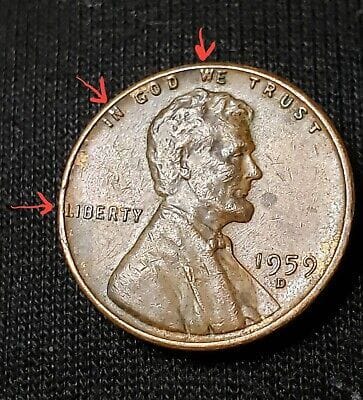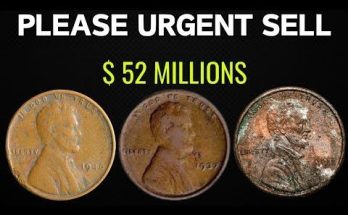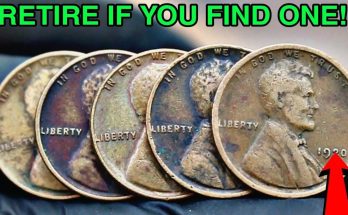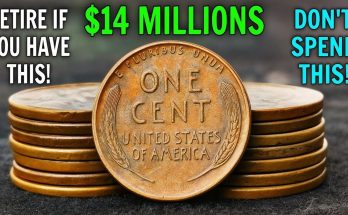1959 D Lincoln Penny – Errors On Top Rim, L On Edge, 1st Year Memorial RARE!!!
1959-D Lincoln Cent, commonly known as a penny, with red arrows pointing to various sections of the coin. The caption “1959 D Lincoln Penny – Errors On Top Rim, L On Edge, 1st Year Memorial RARE!!!” highlights specific purported characteristics of the coin that suggest it might be a valuable rarity. This combination of visual cues and a descriptive caption is designed to attract attention, particularly from coin enthusiasts and those hoping to find a hidden treasure in their loose change.
Let’s break down the claims made in the caption and analyze the visual evidence in the photo.
Firstly, the coin is identified as a “1959 D Lincoln Penny.” The “D” signifies that it was minted in Denver. The year 1959 is significant in the history of the Lincoln Cent because it marked a major design change. Prior to 1959, the reverse side of the Lincoln Cent featured two wheat stalks, giving it the nickname “Wheat Penny.” In 1959, to commemorate the 150th anniversary of Abraham Lincoln’s birth, the reverse design was changed to depict the Lincoln Memorial. This new design continued until 2008. Therefore, the claim “1st Year Memorial” is accurate – 1959 was indeed the first year the Lincoln Memorial reverse was used. However, being the “1st Year Memorial” does not inherently make a 1959-D penny rare or valuable on its own. Millions of these coins were minted. For a coin to be rare and valuable, it typically needs to have a low mintage, significant errors, or be in an exceptionally high, uncirculated grade.
The caption then claims “Errors On Top Rim.” The red arrows in the image point to the rim of the coin, particularly near the words “IN GOD WE TRUST” and “LIBERTY.” Upon close inspection of the image, the areas indicated by the arrows do appear to show some irregularities or inconsistencies on the rim. These could potentially be mint errors, such as:
- Planchet flaws: Imperfections in the metal blank before it was struck.
- Strike errors: Issues that occurred during the striking process, like a weak strike on the rim, or a slight off-center strike that might distort the rim on one side.
- Post-mint damage (PMD): This is a crucial distinction. Many apparent “errors” on coins are actually damage that occurred after the coin left the mint. This could include dings, dents, scratches, or wear from circulation. PMD significantly reduces a coin’s value and is not considered a true mint error by collectors.
Without a clearer, higher-resolution image and examination by a professional numismatist, it’s difficult to definitively determine if these are genuine mint errors or merely post-mint damage. Genuine mint errors, especially significant ones, can indeed increase a coin’s value. Minor or common errors, however, might only add a small premium, if any.
Next, the caption states “L On Edge.” One of the red arrows points directly to the left side of the coin, near the letter “L” in “LIBERTY.” This claim is a bit ambiguous. It’s unclear what “L On Edge” is supposed to refer to. Is it an error related to the letter “L” itself, or is it indicating something on the very edge (the third side) of the coin? Lincoln Cents, like most circulating U.S. coins, have a plain, reeded, or lettered edge depending on their denomination and year. Lincoln Cents have a plain edge. If there’s an “L” on the edge, that would be highly unusual and likely a significant error. However, the arrow points to the face of the coin near the “L” in LIBERTY, not the actual edge (the thickness of the coin). If it refers to an error in the striking of the letter “L” on the obverse, it would need to be a clearly identifiable anomaly like a doubled die or a repunched letter. Again, the image’s resolution makes it hard to confirm any specific detail regarding the “L” beyond normal wear.
Finally, the caption concludes with “RARE!!!” The implication is that because of these supposed errors and its status as the “1st Year Memorial,” this specific 1959-D penny is a rare and valuable find. While the 1959-D cent is a common coin in general circulation, specific and significant mint errors can indeed make a coin rare and valuable. However, the errors would need to be verified by a reputable coin grading service. Exaggerated claims of rarity are common in online postings trying to sell coins or simply generate interest.
To determine the true value and rarity of a coin like this, a professional evaluation is essential. Collectors often look for specific types of errors such as:
- Doubled Die: Where the coin’s design elements appear to be duplicated or stretched.
- Off-Center Strike: Where the coin design is not perfectly centered on the planchet.
- Broadstrike: Where the coin is struck without the retaining collar, causing it to spread out.
- Cud Errors: A piece of the die breaks off, leaving a blank, raised area on the coin.
- Die Cracks: A crack on the die that transfers a raised line onto the coin.
Many “errors” pointed out by amateur collectors turn out to be minor die wear, post-mint damage, or common varieties that do not add significant value. While the 1959-D Lincoln Cent is historically significant as the first year of the Memorial reverse, the claims of “Errors On Top Rim” and “L On Edge” would need rigorous verification. Without professional grading, the “RARE!!!” claim remains largely speculative. This image and caption, therefore, serve as an example of how visual cues are used to build excitement around potentially valuable coin finds, even if the actual rarity and value require further, expert confirmation.



